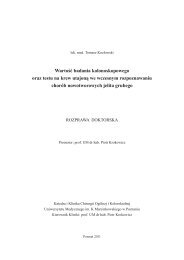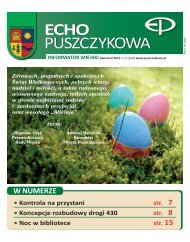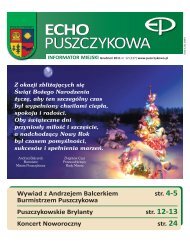© Military Pharmacy and Medicine • 2012 • 4 • 36 – 50Review articleBoth COX-1 and COX-2 catalyze the conversionof arachidonic acid (AA) to prostaglandins andthromboxanes, and the difference between them,besides the fact of both isoforms being encodedby separate genes (located at chromosomes 9 and11, respectively) and besides the structural differences(MW 70 kDa and 70-72 kDa; number ofamino acid residues: 599 and 604; 60% homology)consists in the fact that COX-1 is mainly aconstitutive enzyme, i.e. an enzyme that is presentand active all time, while COX-2 is mainlyan inducible enzyme, becoming active in certaincircumstances, e.g. in the course of inflammation.Therapeutic NSAIDs have different affinitiestowards COX-1 and COX-2, which is dueboth to the structural differences between thedrug molecules, and to the structural and conformationaldifferences between the molecules of(synonymous term: acetaminophen) was and remains one of the most commonanalgesic and antipyretic drugs worldwide, available without prescription bothas a single-agent product or combined with other agents. The anti-inflammatoryeffect of paracetamol is assessed as poor or non-existing, and therefore, the drughas never been considered a member of the NSAID family; what’s interesting,however, it has always been and remains discussed together with this class ofdrugs. Some authors define paracetamol as an atypical NSAID. In recent decades,the prevalent opinion was that paracetamol exerted its analgesic and antipyreticeffect via a central mechanism, and that paracetamol’s effect on the activity ofCOX-1 and COX-2, and thus on the synthesis of prostaglandins, is insignificant.Paracetamol was shown not to inhibit the synthesis of prostaglandins in a tissue/cell homogenate, while exerting such effect in functionally efficient cells (seethe comprehensive discussion on the topic in the article by Graham and Scott,2005 [9]). Graham and Scott argued that the analgesic effect of paracetamolmight be centrally-mediated by activation of descending serotonergic pathways;however, the authors add that the principal stage for the action of the drug mightbe the inhibition of prostaglandin synthesis. The authors further ponder on thepossibility of formation of reactive metabolites at the molecular level as a resultof activation of the peroxidase function of COX-2. Such metabolites would lead todegradation/inactivation of glutathione — a co-factor of enzymes involved inthe synthesis of PGE, and thus to inhibition of the synthesis of PGE 2 . The conceptof paracetamol action involving only the central-mediated, COX-dependentmechanisms does not stand the time test [7]; what is, therefore, the mechanismof paracetamol’s action? The beneficial clinical effects of the drug are beyondall doubt, albeit the knowledge regarding the mechanism of its action is stillincomplete. Contribution from the central serotonergic, or even cannabinoidsystem, is suggested in the effects of paracetamol. The role of cerebral vesselendothelium behind the beneficial therapeutic effects of paracetamol withinthe CNS is also suggested. Studies conducted in recent years revealed thatparacetamol has an inhibitory effect on the activity of both COX-1 and COX-2in peripheral tissues, although to a different degree — a stronger effect wasobserved always in relation to COX-2, particularly in vascular endothelial cells.Articles published in years 2006-2012 and discussing the results of the extensivestudies conducted by Hinz and Brune reveal that paracetamol is a preferentialinhibitor of the COX-2 isoenzyme, although its effect is largely dependent on theenvironmental redox status. The opinion held by the German authors is importantenough to require verification in other centers worldwide, as it is not only themechanism of paracetamol’s therapeutic effect is just concerned, but also theincreasingly often-reported cases of intoxication with this drug, particularly ofpronounced hepatotoxicity resulting from overdosage (intake of more than >4g/day), which is not difficult to achieve as numerous paracetamol-containingproducts are available everywhere and prescription-free.36 http://military.isl-journals.comboth enzymes. Active sites of COX molecules (i.e.substrate binding sites and catalytic domains)are slightly different in both isoenzymes — theyare contained in hydrophobic substrate channelsat the core of the enzyme molecule. In COX-2,the substrate channel is larger — more spaciousand more flexible; thus, COX-2 inhibitors mayenter the channel of the COX-2 molecule (wherethey are able to exert their effects), while beingtoo large to enter the COX-1 channel to block thecatalytic center.This fact translates into the biological activityprofiles of the NSAIDs, particularly in thecontext of their adverse effects. This relates obviouslyto the systemic drugs, not local drugsas ophthalmic NSAIDs, as the side effects if extensiveor long-term therapies with the drugs ofthis group are mostly gastrointestinal (includingserious ulceration effects → onset or complicationsof gastric or duodenal ulcers, includinghemorrhage and perforation) or cardiovascular(thrombotic complications in patients with cardiovasculardisorders and atherosclerosis). Thelist of the adverse effects of NSAIDs is longer,albeit it seems to be not of such importance fortopical treatment; therefore, these considerationswill not be pursued in this article, and interestedreaders may find relevant informationin the recently published article by the same author,titled New NSAIDs and modern forms ofanti-inflammatory drugs (Puls Medycyny — educationalissue, 2012).NSAIDs — Characteristicsand classificationThere is a huge number of NSAIDs available atthe market — they include both the original andgeneric products in formulations suitable e.g. fororal (tablets, capsules), intramuscular and intravenous(liquids for injection), or rectal (suppositories)administrations, as well as ophthalmicpreparations (eye drops).According to the latest edition of the Polishlanguageedited guide-book on drugs currentlyavailable in Poland: Leki Współczesnej Terapii[Medications in Modern Therapy] (20 th ed., MedicalTribune 2010), the most numerous NSAIDproducts contain ibuprofen — 77 simple and 12combination products or diclofenac — 66 simpleand 3 combination products; less numerous
© Military Pharmacy and Medicine • 2012 • 4 • 37 – 50are products containing ketoprofen — 26 simpleproducts and 1 combination product. Manyof these drugs are available without prescription.These products are outnumbered only bymedications containing paracetamol. i.e. ananalgesic and antipyretic drug. It is available in92 products, including 39 simple and as muchas 53 combination products, all availablewithout prescription.NSAIDs are a structurally heterogeneous family ofdrugs, spanning from simple chemical structureslike aspirin to complex, often polycyclic structuresof relatively high molecular weights. Such anumerous and diverse family of medications withsimilar therapeutic indications and a wide spectrumof potentially adverse events requires someorder being introduced by means of classificationthat would take into consideration different propertiesof NSAIDs as regards their chemical structuresand biological activity. However, there is nouniform and worldwide classification of NSAIDs.Later on in the article, two most popular classificationswill be presented, based on either the chemicalstructure of drugs, or their affinity to individualcyclooxygenase subtypes. [3] Both classifications areimportant, since understanding of the chemicalstructure and biological role of COX isoenzymesallows the assessment of particular drugs in functionalterms, i.e. from the standpoint of both therapeutic,and potential adverse effects thereof.NSAIDs are classified by their chemical structuresinto four groups of carboxylic acids, enolicacids, naphtyl ketone derivatives and coxibs.Jerzy Z. Nowak: Non-steroidal anti-inflammatory drugs (NSAIDs) in …••acetic acid — e.g. bromfenac, diclofenac,ketorolac, nepafenac, sulindac;••propionic acid — flurbiprofen, suprofen, pranoprofen,flurbiprofen, ibuprofen, ketoprofen,tiaprofenic acid, naproxene;••anthranilic acid — flufenamic acid, mefenamicacid, meclofenamic acid, niflumic acid;••indole — indomethacin, acemetacinEnolic acids include:••Pyrrazolone derivatives, e.g. aminophenazone,phenylbutazone, metamizole (pyralgin),oxyphenbutazone;••Oxicams, e.g. meloxicam, pyroxicam;Naphtyl ketones — e.g. nabumetone.Coxibs — celecoxib (available in Poland undertrade name Celebrex), the only coxib currentlyused in therapy. Other coxibs, available in thedrug market until recently, such as valdecoxib(Bextra by Pfizer; removed in 2005), and lumiracoxib,etoricoxib shared the fate of the first coxibrecalled from the market in 2004, i.e. rofecoxib(Vioxx by Merck) due to their potential cardiovascularadverse effects.When discussing this classification, one shouldalso mention drugs related to NSAIDs, havingthe analgesic and antipyretic activity and devoidof anti-inflammatory effects, such as paracetamol(acetaminophen) and phenacetin (not longerin the pharmacopoeia, previously known as theingredient in popular APC — aspirin/phenacetin/caffeine— tablets), which are the derivativesof 4-aminophenol.Carboxylic acids include the derivatives of:• • salicylic acid — various salicylates and acetylsalicylicacid (aspirin);[3] As on case of other drugs, NSAIDs may also be classified in sequentialgenerations; such classification highlights certain structural innovations orupgrades, which are the effects of researchers’ strive for drugs characterized bybetter safety (in terms of the adverse events profiles) or better bioavailability andpharmacodynamic parameters. The classification of NSAIDs into three generationsis mentioned by some studies on the topic; however, such classification may notreplace either of the two classifications mentioned above. The generation-basedclassification is as follows:1 st generation — drugs that preferentially inhibit COX-1 (COX-1>COX-2) — Vaneet al. group 1 drugs.2 nd generation — drugs relatively selective towards COX-2 (COX-2>COX-1), e.g.etodolac, meloxicam, nabumetone, nimesulide.3 rd generation — coxibs (selective drugs) characterized by >200 times higheraffinity towards COX-2 compared to COX-1.http://military.isl-journals.comThe widely used classification of NSAIDs basedon their affinity to individual COX isoenzymeswas proposed by Vane et al.; it divides all NSAIDsinto 4 groups:1) Drugs that completely inhibit COX-1 andCOX-2 with low selectivity but a pronouncedpreference towards COX-1; e.g.. aspirin(ASA), diclofenac, ibuprofen, indomethacin,naproxen, piroxicam, as well as bromfenac,flurbiprofen, ketorolac, nepafenac, suprofenpranoprofen, fenoprofen.2) Drugs that inhibit COX-2 with a selectivitythat is 5–50 times higher comparedto COX-1, e.g. celecoxib, meloxicam,nimesulide.37
















